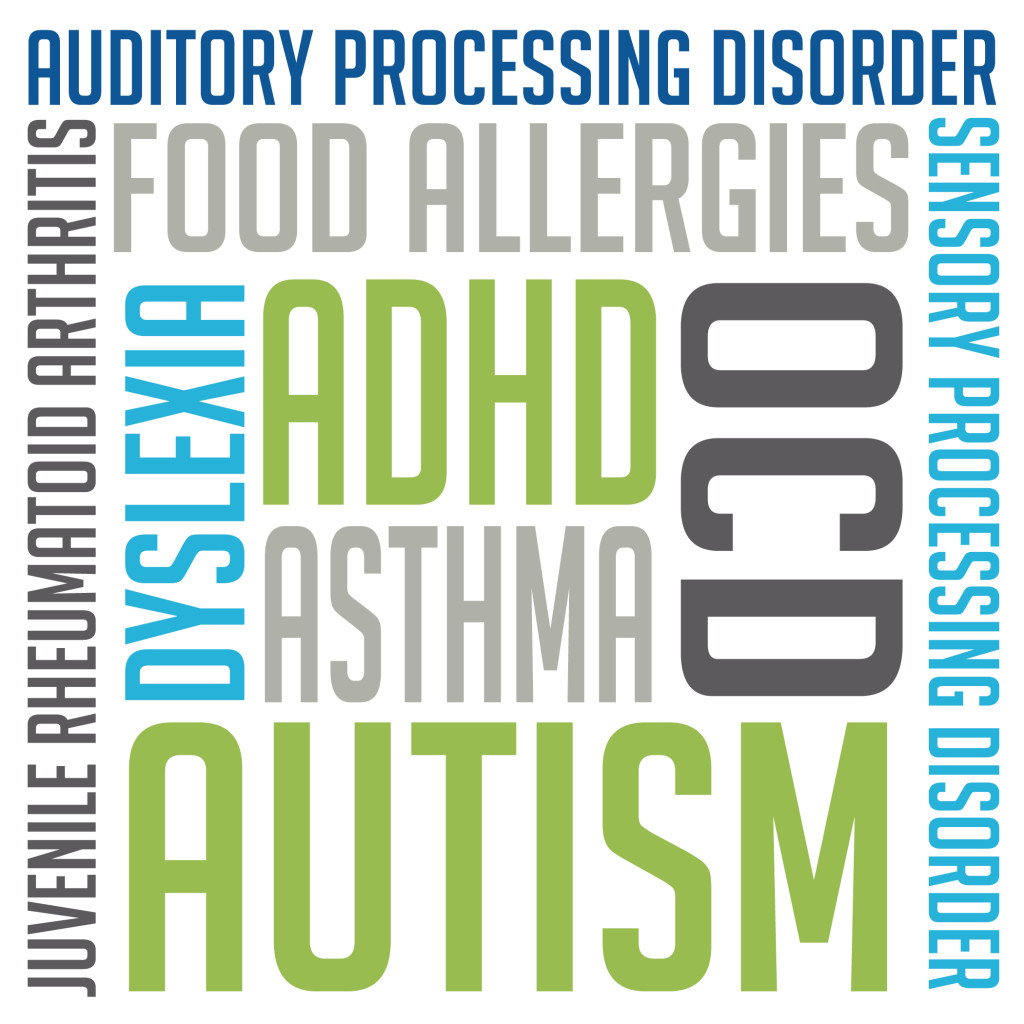Is There a Root Cause for the “New Normal”?
Perhaps it begins with a colicky baby who cannot be put down, or with a mother’s instinct that something is not quite right. There may be evolving and revolving diagnoses such as autism spectrum disorder (ASD), sensory processing disorder (SPD), attention deficit disorder (ADD), attention deficit hyperactivity disorder (ADHD), oppositional defiance disorder (ODD), obsessive compulsive disorder (OCD), Postural Orthostatic Tachycardia Syndrome (POTS), auditory processing disorder (APD) or some other acronym, an alphabet soup of labels. The children may present with food allergies, infant reflux, celiac disease, Crohn’s disease, juvenile rheumatoid arthritis, headaches, joint pain, anxiety, depression, or may be prone to repeat infections. Children are frequently ordered to undergo speech therapy, occupational therapy, or cognitive behavioral therapy. Symptoms may wax, wane, or migrate as children get older, or perhaps suddenly explode after exposed to another infection or vaccination.
This phenomenon of children who all seem to have some form of chronic health condition has been described as the “new normal.” We ask: why would we ever settle for this form of “normal”? Why is this happening to our precious children? What is a parent supposed to do when mainstream medicine fails to provide answers? Should we simply accept these labels or worse, accept the label “medically unexplained symptoms” as some doctors suggest? Concerned mothers who research and advocate for their children are often admonished and chided to stay off the internet because they have the audacity to educate themselves about medical issues without going to medical school. Fortunately, every day, brave mothers help to pave a path to wellness as they fight to recover their own children and help others do the same.
While many doctors are great at diagnosing and prescribing medications or therapies to address each of the separate symptoms, very few look for a common denominator – a root cause -that could be Lyme Disease. Many parents of kids who have Lyme Disease did not initially receive a Lyme diagnosis and frequently had to figure out on their own that Lyme Disease was the culprit. In hindsight, it makes perfect sense – Lyme Disease causes immune suppression, chronic inflammation and gut dysbiosis, common factors often seen in chronically ill children.
How Does Lyme Disease Impact Children?
Lyme pediatric specialist Charles Ray Jones, M.D. and other leading Lyme specialists have compiled a list of common symptoms of infection in young patients:
- fatigue unrelieved by rest
- insomnia
- headaches
- mitochondrial dysfunction
- syncope, POTS or Neurally Mediated Hypotension
- nausea, abdominal pain
- seizure disorders
- impaired concentration
- poor short-term memory
- inability to sustain attention
- difficulty thinking and expressing thoughts
- immune deficiencies
- difficulty reading and writing
- overwhelmed by schoolwork
- difficulty making decisions
- confusion
- outbursts and mood swings
- fevers/chills
- dizziness
- noise and light sensitivity
- increased incidence of ear and throat infections
- increased incidence of pneumonia
- irritability
- joint and body pain
- poor muscle tone
- gastroesophageal reflux
- small windpipe (tracheomalacia)
- cataracts and other eye problems
- developmental delays (language, motor)
- learning disabilities
- psychiatric problems (anxiety, depression, OCD)
- autism or Asperger’s type presentation
Children do not typically have all of these symptoms, but rather, a cluster of seemingly unrelated conditions that are often overlooked by pediatricians and specialists. Often, a child is diagnosed with changing conditions because their symptoms and presentation do not quite “fit”, but doctors acknowledge that something is wrong. Among Jones’ patients, 50% have no known history of deer tick (also known as black legged tick) attachments and fewer than 10% have a history of the bull’s eye rash.
What About Babies?
Did you know that Lyme Disease and other tick-borne infections can be spread from mother to child during pregnancy? Women who have undiagnosed Lyme Disease infections may unknowingly pass them on to their babies. There are documented cases where the pathogens that cause Lyme Disease, Babesia, and Bartonella have been found in newborn infants, placentae, fetuses, or umbilical cords. These children are generally more fragile and susceptible to injury or reactions from vaccines, environmental exposures, and infections.
Congenital transmission is yet another reason why children are at the greatest risk of contracting Lyme Disease. Children born with Lyme Disease can present with a variety of neurological or physical impairments. We recommend for mothers and women of child-bearing age who have been diagnosed with fibromyalgia, chronic fatigue syndrome, autoimmune conditions, unexplained inflammation,immune deficiencies, psychiatric conditions such as depression or anxiety, joint pain or muscle pain to carefully consider Lyme Disease as part of the differential diagnosis, preferably under the guidance of a knowledgeable provider and using more reliable tests.
How is Lyme Disease Diagnosed?
Perhaps the biggest obstacle hindering parents and clinicians from connecting the dots between Lyme Disease and other conditions is the lack of reliable diagnostic tests. The currently available tests for Lyme Disease recommended by the CDC miss about 50% of actual cases according to numerous peer reviewed studies. Children who have a late stage infection or may have been born with Lyme Disease are less likely to mount the vigorous immune response that is needed to test positive using the CDC’s criteria. It is also critical to note that CDC-endorsed blood tests were only developed to detect a single strain of Borrelia, even although there are hundreds of different strains that infect humans worldwide.
So what happens to those who do not have the “right” strain of Borrelia but are still sick? Or to those who have immune suppression due to a late stage Lyme infection? Even if doctors think to test for Lyme Disease, in all likelihood, the patient will test negative and may instead be given a label diagnosis such as Multiple Sclerosis (MS), Amyotrophic Lateral Sclerosis (ALS), fibromyalgia, lupus, chronic fatigue syndrome, Parkinson’s, Alzheimer’s, Rheumatoid arthritis (RA), ASD, SPD, ADD, ADHD, or ODD.
But We Don’t Have Lyme Disease Where I Live!
Most people think that Lyme Disease only occurs in the Northeast, in part because it is named after a small town in Lyme, Connecticut where symptoms were first observed in a cluster of children in the 1970s.
The reality is that Lyme Disease has been around for thousands of years. Indeed, a recent autopsy on a 5,300-year-old mummy revealed the genetic footprint of bacteria of Borrelia burgdorferi in his DNA—making “Ötzi,” the Iceman, the earliest known human infected by the bacteria that causes Lyme Disease. Cases describing Lyme-like symptoms, including the classic erythema migrans (bulls-eye rash, a classic manifestation of Lyme) have been described for over a hundred years.
For some unknown reason, the CDC has chosen to narrowly define Lyme Disease to cover a single strain of Borrelia, a single mode of transmission by 1-2 species of ticks, in a small geographic area. When incidence maps are drawn, other areas of the country are essentially ignored, doctors are told that Lyme Disease is rare outside the northeast, and little if any funds are allocated to track the disease outside of the “high incidence” areas. Don’t be fooled – Lyme Disease is everywhere. Lyme Disease and tick-borne diseases are prevalent across the entire United States and has been found on every continent except Antarctica.
What can I do?
Help spread awareness. Take the Lyme Disease Challenge, share the facts and spread the word about the fastest growing infectious disease.
We absolutely need more research from a variety of researchers and perspectives, and improved testing that can detect Borrelia burgdorferi as well as other tick-borne infections. With your help and donation, we can help raise awareness and funds for much needed research.
We also encourage any parents of children with symptoms of Lyme Disease to strongly consider Lyme testing, preferably using more reliable laboratory tests under the guidance of a Lyme specialist.


